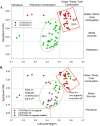Relative Influence of Trans-Pacific and Regional Atmospheric Transport of PAHs in the Pacific Northwest, U.S
- PMID: 26151337
- PMCID: PMC4666789
- DOI: 10.1021/acs.est.5b00800
Relative Influence of Trans-Pacific and Regional Atmospheric Transport of PAHs in the Pacific Northwest, U.S
Abstract
The relative influences of trans-Pacific and regional atmospheric transport on measured concentrations of polycyclic aromatic hydrocarbons (PAHs), PAH derivatives (nitro- (NPAH) and oxy-(OPAH)), organic carbon (OC), and particulate matter (PM) less than 2.5 μm in diameter (PM2.5) were investigated in the Pacific Northwest, U.S. in 2010-2011. Ambient high volume PM2.5 air samples were collected at two sites in the Pacific Northwest: (1.) Mount Bachelor Observatory (MBO) in the Oregon Cascade Range (2763 m above sea level (asl)) and 2.) Confederated Tribes of the Umatilla Indian Reservation (CTUIR) in the Columbia River Gorge (CRG) (954 m asl). At MBO, the 1,8-dinitropyrene concentration was significantly positively correlated with the time a sampled air mass spent over Asia, suggesting that this NPAH may be a good marker for trans-Pacific atmospheric transport. At CTUIR, NOx, CO2, and SO2 emissions from a 585 MW coal fired power plant, in Boardman OR, were found to be significantly positively correlated with PAH, OPAH, NPAH, OC, and PM2.5 concentrations. By comparing the Boardman Plant operational time frames when the plant was operating to when it was shut down, the plant was found to contribute a large percentage of the measured PAH (67%), NPAH (91%), OPAH (54%), PM2.5 (39%), and OC (38%) concentrations at CTUIR and the CRG prior to Spring 2011 and likely masked trans-Pacific atmospheric transport events to the CRG. Upgrades installed to the Boardman Plant in the spring of 2011 dramatically reduced the plant's contribution to PAH and OPAH concentrations (by ∼72% and ∼40%, respectively) at CTUIR and the CRG, but not NPAH, PM2.5 or OC concentrations.
Conflict of interest statement
The authors declare no competing financial interest.
Figures




Similar articles
-
Concentration and photochemistry of PAHs, NPAHs, and OPAHs and toxicity of PM2.5 during the Beijing Olympic Games.Environ Sci Technol. 2011 Aug 15;45(16):6887-95. doi: 10.1021/es201443z. Epub 2011 Jul 18. Environ Sci Technol. 2011. PMID: 21766847 Free PMC article.
-
Chemical Characteristics of Atmospheric PM10 and PM2.5 at a Rural Site of Lijiang City, China.Int J Environ Res Public Health. 2020 Dec 20;17(24):9553. doi: 10.3390/ijerph17249553. Int J Environ Res Public Health. 2020. PMID: 33419360 Free PMC article.
-
Impact of local and regional sources of PAHs on tribal reservation air quality in the U.S. Pacific Northwest.Sci Total Environ. 2020 Mar 25;710:136412. doi: 10.1016/j.scitotenv.2019.136412. Epub 2020 Jan 5. Sci Total Environ. 2020. PMID: 31927295 Free PMC article.
-
Occurrence, spatial patterns, air-seawater exchange, and atmospheric deposition of polycyclic aromatic hydrocarbons (PAHs) from the Northwest Pacific to Arctic Ocean.Mar Environ Res. 2023 Jan;183:105793. doi: 10.1016/j.marenvres.2022.105793. Epub 2022 Nov 7. Mar Environ Res. 2023. PMID: 36371950 Review.
-
Children environmental exposure to particulate matter and polycyclic aromatic hydrocarbons and biomonitoring in school environments: A review on indoor and outdoor exposure levels, major sources and health impacts.Environ Int. 2019 Mar;124:180-204. doi: 10.1016/j.envint.2018.12.052. Epub 2019 Jan 14. Environ Int. 2019. PMID: 30654326 Review.
Cited by
-
Oxygenated and Nitrated Polycyclic Aromatic Hydrocarbons in Ambient Air-Levels, Phase Partitioning, Mass Size Distributions, and Inhalation Bioaccessibility.Environ Sci Technol. 2020 Mar 3;54(5):2615-2625. doi: 10.1021/acs.est.9b06820. Epub 2020 Feb 11. Environ Sci Technol. 2020. PMID: 31950831 Free PMC article.
-
Pollution and health: a progress update.Lancet Planet Health. 2022 Jun;6(6):e535-e547. doi: 10.1016/S2542-5196(22)00090-0. Epub 2022 May 18. Lancet Planet Health. 2022. PMID: 35594895 Free PMC article. Review.
-
Pharmaceuticals and Microplastics in Aquatic Environments: A Comprehensive Review of Pathways and Distribution, Toxicological and Ecological Effects.Int J Environ Res Public Health. 2025 May 20;22(5):799. doi: 10.3390/ijerph22050799. Int J Environ Res Public Health. 2025. PMID: 40427912 Free PMC article. Review.
-
The Superfund Research Program Analytics Portal: linking environmental chemical exposure to biological phenotypes.Sci Data. 2023 Mar 21;10(1):151. doi: 10.1038/s41597-023-02021-5. Sci Data. 2023. PMID: 36944655 Free PMC article.
-
Identification and Toxicological Evaluation of Unsubstituted PAHs and Novel PAH Derivatives in Pavement Sealcoat Products.Environ Sci Technol Lett. 2016;3(6):234-242. Epub 2016 Apr 25. Environ Sci Technol Lett. 2016. PMID: 30079367 Free PMC article.
References
-
- Finlayson-Pitts B. J.; Pitts J. N. Tropospheric air pollution: Ozone, airborne toxics, polycyclic aromatic hydrocarbons, and particles. Science 1997, 276 (5315), 1045–1051. - PubMed
-
- Chen Y.; Sheng G.; Bi X.; Feng Y.; Mai B.; Fu J. Emission factors for carbonaceous particles and polycyclic aromatic hydrocarbons from residential coal combustion in China. Environ. Sci. Technol. 2005, 39 (6), 1861–1867. - PubMed
-
- Xu S.; Liu W.; Tao S. Emission of polycyclic aromatic hydrocarbons in China. Environ. Sci. Technol. 2006, 40 (3), 702–708. - PubMed
-
- Marr L. C.; Kirchstetter T. W.; Harley R. A.; Miguel A. H.; Hering S. V.; Hammond S. K. Characterization of polycyclic aromatic hydrocarbons in motor vehicle fuels and exhaust emissions. Environ. Sci. Technol. 1999, 33 (18), 3091–3099.
Publication types
MeSH terms
Substances
Grants and funding
LinkOut - more resources
Full Text Sources
Other Literature Sources

